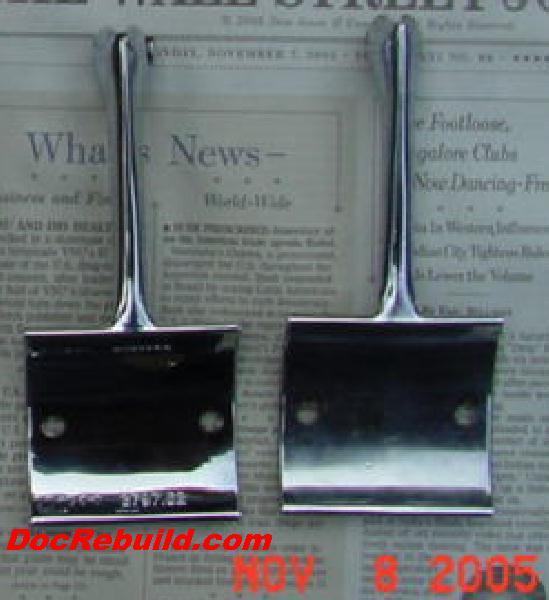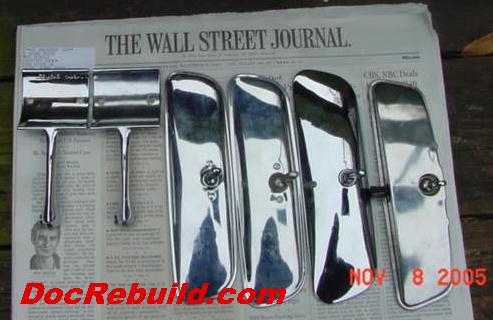| |||
| Seldom do we encounter a part that does not fit or function as intended. Often only a little technical assistance is required for a remedy. Whenever we do get a return for fit or function, I examine and test the item to determine if there is a problem. There is no point in us continuing to market an item if it is defective, as no sale is made and everyone is disappointed. I am obligated both morally and financially to determine if we actually have a fit or function problem. | |||
| A woman with a 1963 wrote me "the yoke on the repro mirror support was too wide and the mirror could not be properly installed. I have installed the original pitted bracket in the car which fits correctly with the mirror". I was dumbfounded as we never have had any type of claim for this part, so I trudged out to my garage and grabbed several original GM parts for comparison. | |||
|
The repro (on the left) is easy to ID because it has the GM part number on the back side, as well as the manufacturer's CMD logo and a date and/or cavity code. My original 1963 GM support (on the right is not re-plated) and it had no ID on the hidden side. |
|||
I took lots of measurement of both parts to see how faithful this particular repro sample matched a genuine GM part and was not surprised that there was +/- .001 to .003 variance. That's the thickness of a common human hair. |
|||
|
The repro inside mirror support that was returned; a GM 1963-1966 inside mirror support; a 1963 GM mirror with stainless rivets; a 1963 GM mirror with plain rivets; a 1963-1966 GM die cast service replacement mirror and a 1965-1966 GM day night inside mirror. |
|||
| I measured the gap on the "yoke" with my vernier caliper. My old original 1963 has a gap of .188 and the CMD repro is .189. It's a .001 wider and apparently this difference of a cootie hair is thought to impair some function. However, I am at a loss to understand how this could produce any problem. | |||
| Every GM blueprint from the 50's, 60's and 70's (of the hundreds that I have), show +/- tolerances of .01, .02 or .03 which is considerably larger magnitude than .001 or .002 or .003. Critical parts like bearing probably have smaller tolerances, but this is a mirror support. | |||
| I also mounted 4 different authentic GM mirrors to the "yoke" of the repro mirror support and all slid into place un-remarkably well. And when the mounting machine screw was tightened, all four un-remarkably stayed in the position as intended. Each is shown on the links below. |
|||
| I also measured across the flats on the GM mirror ball studs that are inserted into the supports "yoke". I found nothing really remarkable as they measured .185 to .187 across the flats. The only remarkable thing I could easily discern is the better than GM chrome plating that is present on the repro. For decades I have said you cannot market a crappy chrome plated part equivalent to the OEM. The repro chrome must be better, simply because only GM could market a marginally chrome plated part. But, there is no complaint here for that parameter. I am clueless understanding exactly what it is that doesn't fit. I must be missing something, because I assembled these with zero force and they fit perfectly and nothing flops around or is loose. Has anyone run into any type of problem with a repro 1963-1966 inside mirror support or is the yoke on me? |
|||
| Please email me if you have any clues. DocRebuild at aol dot com. | |||
| | |||
| |
|||
 To the right are 2 inside mirror
support for any 1963-1966. This chrome plated Zinc casting mounts to the
inside header trim molding above the windshield and in turn has one machine
screw that mounts it to the ball stud on the backside of the inside mirror.
To the right are 2 inside mirror
support for any 1963-1966. This chrome plated Zinc casting mounts to the
inside header trim molding above the windshield and in turn has one machine
screw that mounts it to the ball stud on the backside of the inside mirror.
 Left to Right:
Left to Right: